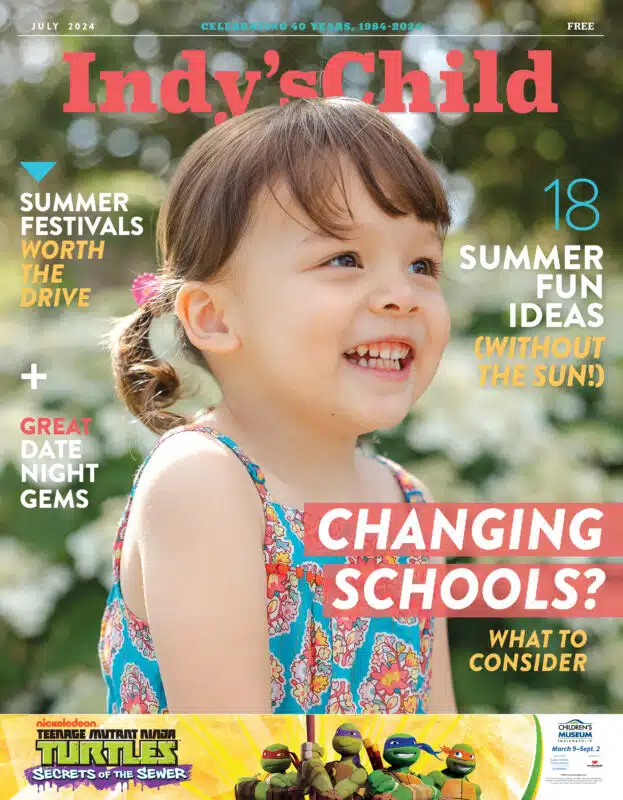In honor of Autism Awareness Month, we share this article from our April issue on detecting the early signs of autism. Indianapolis has a number of resources available to families, including Indiana First Steps. If you have any questions or concerns, we recommend families first schedule an appointment to talk with their pediatricians.
Parenthood has always come with plenty of questions: Is my child growing normally? Is he getting enough sleep? Is she meeting her nutritional needs? But today’s moms and dads may also be asking a question previous generations did not: Could my child have autism?
According to the Centers for Disease Control and Prevention, one in every 68 children is diagnosed with autism spectrum disorder (ASD.) A government survey in 2015 puts the rate even higher at 1 in 45 children.
The developmental disorder is being detected earlier and earlier, sometimes even before babies have their first birthday, thanks to more public awareness and education programs. Spotting autism is far from an exact science however. Early warning signs of autism can be tricky to discern from typical phases of childhood development, and they vary in severity from child to child.
“I’ve been in the field for 20 years, and I’m still trying to identify early red flags,” says Dr. Edward Parker, Clinical Director for Unlocking the Spectrum, which provides autism therapy across Indiana. “Before the age of 2, it can be a challenge to pick up on, compared to when [a child is] 4 or 5 years old. But by then, you’ve missed two or three years of early intervention services.”
While some behaviors are commonly associated with kids on the spectrum – such as hand flapping or tiptoe walking – experts also encourage parents to observe how their child learns, communicates and interacts with others, which are key areas in which children with autism often struggle.
Here are some early sings of autism that may warrant a professional evaluation:
Difficulty communicating
While we typically equate communication with talking, deficits in this area can be spotted well before a child begins to speak. Pointing, babbling, smiling and making eye contact are all forms of subtle, nonverbal communication between child and caregiver, and a lack of these skills can be an early indicator of a problem.
“Individuals with ASD show challenges with such responses and alternatively appear to be aloof, non-communicative and disinterested, as well as potentially even confused or distressed within the social context around them,” says Naomi B. Swiezy, Program Director at the Christian Sarkine Autism Treatment Center and Director of HANDS in Autism in Indianapolis.
Once speech begins, a typically developing child should have several words in his or her vocabulary by 18 months, and will likely use multiple-word phrases like “I go now” or “my ball” by the age of 2.
For children on the autism spectrum though, this is when a language deficit can begin to show. They are more likely to use more grunts and sounds and may just have words for “no” or “mama.” Parents may find that the child only communicates when he or she needs something. For example, a typically developing child will bring a toy elephant to a parent and say, “Elephant!” But for a child with autism, they will often only interact if they need the parent to get more toy animals or if the parent tries to take the animal away. Any other interaction about the toy will be from the parent to the child, and it won’t be conversational in nature. If a child does acquire new words but then suddenly stops using them, this can also be an important warning sign.
Trouble with social cues
Another area of major difference between typically developing children and those with autism is the need for and interpretation of social cues.
Imagine a child, between 18 months and 2 years old, waiting with his mother to see the pediatrician. When the doctor comes in, a typically developing child will look at the parent and then at the doctor to observe how his mother is reacting. Is mom smiling? Is she tense? The child will respond to the parent’s facial expressions, perhaps hugging her closer.
A child with autism may not recognize that the person is in the room at all, or recognize the person is present but be interested in them only to see if they have something he or she wants, like a toy.
“Parents should also see their children pointing out things that they like. We call this joint attention,” says Mary Rosswurm, Director of Little Star Center, which provides therapy for children with autism at centers across the state. “So if a child sees a dog and is excited, we would expect a typically developing child to try to get his mom or dad’s attention and pointing out the dog. Even if the child is pre-vocal, he should be trying to share his pleasures with others.”
Difficulty with imaginative play
This lack of interest in social interactions can also impact how children with autism play.
Children on the spectrum may be more interested in examining the individual features of toys – wheels, buttons, sounds – rather than playing with them in a typical way. “They may love a toy car, but instead of pushing the car around and pretending that it is driving, they may fixate on one specific part, like the wheels that spin or the doors that open and shut,” Rosswurm says.
Likewise, common imaginative social play among preschoolers, such as cooking and eating pretend food together, do not come naturally for children with autism. “Those are things that kids with autism simply do not do; not only 2-year-olds, there are 20-year-olds with autism who can’t engage in pretend play like that,” Parker says.
Lack of imitation/ No passive learning
Because of their intense focus and ambivalence to social interactions, children with autism don’t learn through observation and imitation the way most children do.
As any parent of a typically developing child knows, kids are watching and listening to us all the time. Even when we don’t realize it, they repeat back words, copy mannerisms and pick up details about the world around them. Parker gives the example of his own 2-year-old son, who will look in the refrigerator and say, “I want this” while pointing at the yogurt. He doesn’t have a label for the snack yet, but he knows he has experienced it and that he liked it.
For children with autism, this is more difficult, with skills like requesting something or imitating an action taking repeated academic training to learn. “Children with autism typically learn through cause and effect. It’s rare that they’re passively exposed to things and pick them up,” Parker says. “A typically developing child is learning just from being with others and listening, but a child with autism is not going to do that.”
Repetitive behaviors
Engaging in repetitive or ritualistic behaviors can be another sign to evaluate for autism. These behaviors can involve motor movements or vocal sounds, including actions like hand flapping, flicking fingers and tiptoe walking, or self-injurious behavior, such as repeatedly banging one’s head against the wall. Having a fascination with the repetitive movement of objects also qualifies.
“One parent told me that she was first concerned that her son might have autism when he was playing in a sandbox at a birthday party. Something else happened and all of the other kids got up and went to check it out, but her son just stayed in the sandbox and watched sand pouring out of a cup over and over again for more than an hour,” Parker recalls.
A child with autism might also spend a significant amount of time seeking sensory input, such as wedging themselves into tight spaces, slamming into objects or people or spinning in circles. While typically developing children might exhibit these behaviors near bedtime when they’re wound up and overtired for example, children with autism will engage in these actions for hours if allowed.
Extreme sensitivity to environment
Some children with autism may be extra sensitive to the sights, sounds and smells of their environment. Others are averse to physical interaction of any kind. Parents of babies and toddlers with autism often report that their child only stops crying if he or she is put down and left alone, the opposite of what most young children would want.
Similarly, it may be a red flag if minor changes to the child’s environment, such as moving a piece of furniture, changing the light source or playing a game in a different sequence, cause major distress.
Experts stress that autism is a spectrum disorder, so no two children will present characteristics in exactly the same way. Still, these red flags are some of the basic ways in which autism can affect how a child communicates, interacts and learns new skills.
The earlier parents and doctors pick up on a potential problem, the sooner early intervention can begin closing the gaps. “There’s very little difference between a 3-year-old child with autism who has not received intervention and a 30-year-old individual who has not received intervention. It just hurts more when a 30-year old hits you,” Parker says. “Autism is a lifelong disability, and without intervention, individuals will be more and more affected by it.”
Swiezy agrees and encourages parents not to hesitate bringing any concerns to the attention of their child’s pediatrician or another medical professional. Screenings are fast, simple and look for other developmental delays besides autism, too. “Very simply, if there is any red flag, the most conservative thing to do is to seek a referral for diagnosis,” says Swiezy. “If the evaluation results in failing to identify a disorder or problem, that is tremendous. However, if a disorder is present, we want to catch it early.”
Families can also contact Indiana First Steps, a government early intervention program that provides evaluations and services for infants and toddlers up to age 3 who are experiencing or have a high probability for developmental delays. Find more information at www.in.gov/fssa/4655.htm.
About Maggie:
Maggie Loiselle spent 10 years as a writer, producer and web editor in television news before making the switch to freelance writing in order to stay home with her young son. She is a Michigan native and a graduate of Butler University. Maggie lives in downtown Indianapolis with her husband and son.
Watch for more of Maggie’s work in upcoming issues of Indy’s Child Parenting, Cincinnati Parent and Dayton Parent Magazines.







